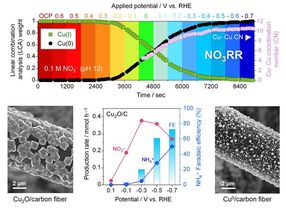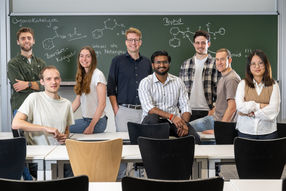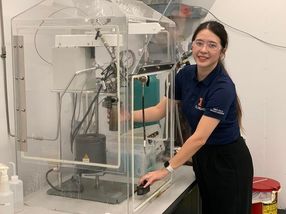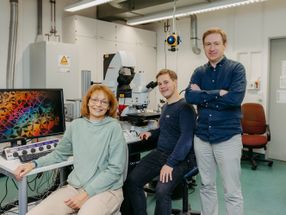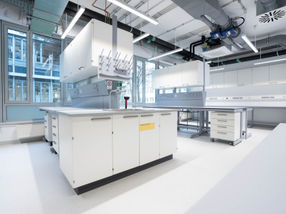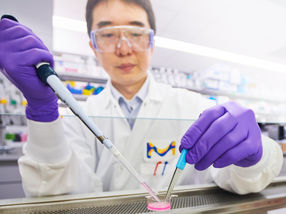Booster for the energy transition: Kiel research team wants to optimize hydrogen production
Advertisement
When ships powered by green hydrogen sail the world's oceans in the near future, scientists from Kiel will also have made their contribution. A research team from HAW Kiel and Kiel University is currently working together with the company Phi-Stone AG to optimize hydrogen production through capillary electrolysis and ultimately make it more cost-effective. The increase in efficiency is to be achieved through innovative materials for the membrane and a more intelligent electronic control system. The CAPTN Energy project "Innovative materials and power supplies for hydrogen electrolysis" is receiving over 870,000 euros from the Federal Ministry of Education and Research.
The International Maritime Organization of the United Nations (IMO) has formulated a clear goal: The fleets of its 176 member countries are to be climate-neutral by 2050, and 40 percent by 2030. This is an ambitious plan, as 98.8 percent of ships were still using conventional fossil fuels in 2024. The maritime industry must therefore use climate-neutral energy sources in the future. The conversion of renewable energies into green hydrogen using electrolysis is particularly attractive for the maritime energy transition. The hydrogen produced in this way can power ships in the form of fuel cells or be converted into other sustainable fuels. The problem is that demand is huge and the production of hydrogen is still expensive and inefficient.
New material concepts should enable capillary electrolysis on an industrial scale
This is precisely where the CAPTN Energy project "Innovative materials and power supplies for hydrogen electrolysis" comes in. The cooperation partners HAW Kiel and CAU Kiel want to develop efficient materials and power supply solutions for the capillary electrolysis process in collaboration with Phi-Stone AG, based in Mielkendorf near Kiel. Capillary electrolysis uses an electrolysis cell that produces hydrogen and oxygen through a porous, hydrophilic membrane. Conventional electrolysis has an efficiency of between 60 and 80 percent, while capillary electrolysis promises efficiencies of well over 90 percent, explains Prof. Dr. Rainer Adelung, head of the Functional Nanomaterials working group at the Institute of Materials Science at Kiel University. This process is already very efficient: "However, it was initially only presented as a research concept. We need new, highly scalable material concepts for capillary electrolysis that enable cost-efficient electrolysis on an industrial scale. We want to develop these as part of the project."
Gallium nitride power semiconductors to control electrolysis cells more efficiently
Another key to greater efficiency and therefore more cost-effective hydrogen production lies in the control of the electrolysis cell, which generates the necessary voltage for the electrolysis process. Overall project manager Ulf Schümann (HAW Kiel) will develop the control system as part of the project. Schümann is investigating the extent to which pulsing the voltage can increase the efficiency of the electrolysis cell. The Professor of Power Electronics and Electrical Drives is focusing on gallium nitride power semiconductors. "Up to now, silicon-based power semiconductors have been used. Gallium nitride as a material has the potential to be much more efficient as it has a significantly lower on-state resistance," explains Schümann.
The costs per kilogram of hydrogen and therefore the efficiency of the value chain in the production of hydrogen are crucial for the success of the energy transition, emphasizes Schümann. Currently, around 52.5 kWh of electrical energy is required per kilogram of hydrogen. Capillary electrolysis promises to reduce the energy requirement to less than 42 kWh per kilogram of hydrogen. "This reduces energy consumption by 20 percent," explains Schümann. This naturally has a direct impact on the cost of hydrogen production and the price of hydrogen.
Industrial partner contributes tetrapodal zinc oxide
The third project partner is Phi-Stone AG, a company spun off from the CAU Faculty of Engineering. The industrial partner, explains Dr. Daniel Hugenbusch, Head of the Research and Development Department, will produce the scalable capillary materials to be developed: "Phi-Stone AG produces so-called tetrapodal zinc oxide under clean room conditions on a highly scaled-up scale, which is used in medical and cosmetic products due to its outstanding antimicrobial properties. From a technical point of view, there are further areas of application, as tetrapodal zinc oxide is the basis for a variety of innovative materials as a template material. We will exploit these properties for the electrode materials developed in parallel as part of this project."
Federal and state governments support the CAPTN Energy project
The Kiel CAPTN Energy project "Innovative materials and power supplies for hydrogen electrolysis" is being funded by the Federal Ministry of Research, Technology and Space with around 870,000 euros as part of the WIR! The Ministry for Energy Transition, Climate Protection Environment and Nature of the State of Schleswig-Holstein is participating with co-financing. The project will run for three years.
Note: This article has been translated using a computer system without human intervention. LUMITOS offers these automatic translations to present a wider range of current news. Since this article has been translated with automatic translation, it is possible that it contains errors in vocabulary, syntax or grammar. The original article in German can be found here.
Other news from the department science
Most read news
More news from our other portals
Something is happening in the chemical industry ...
This is what true pioneering spirit looks like: Plenty of innovative start-ups are bringing fresh ideas, lifeblood and entrepreneurial spirit to change tomorrow's world for the better. Immerse yourself in the world of these young companies and take the opportunity to get in touch with the founders.





